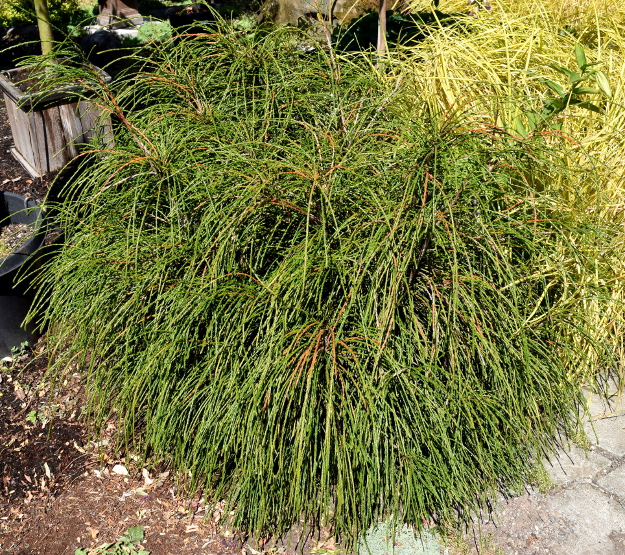
‘Whipcord’ arborvitae (Thuja plicata ‘Whipcord’) is a cool, quirky dwarf conifer that has been on my wishlist for quite some time. Instead of the usual flattened sprays of foliage, this lovable mutant form of our native western arborvitae, or western red cedar, sports a mop top of long, skinny, green rat tails. It tops out at around 4 to 5 feet tall and wide, making it easy to integrate into modestly sized gardens.
I was smitten by ‘Whipcord’ the first time I saw it several years ago. I had second thoughts, however, after I noticed that some plants appeared to develop browning in their centers after growing in the landscape for a few years. ‘Whipcord’ won me back when I saw this good-sized specimen at the Cornell Farm display beds in the West Hills of Portland last summer. It was growing in a parking lot island, and it was perfect.

You can also buy ‘Whipcord’ grafted onto a standard, so its crazy hairdo is raised off the ground.
‘Whipcord’ originated as a chance seedling at Drakes Crossing Nursery in Silverton, Oregon in 1986. It was introduced by Barbara Hupp in 1999, but it wasn’t patented. Drakes Crossing is a wholesale nursery that sells small seedling trees to nurseries and Christmas tree farms. ‘Whipcord’ isn’t the kind of plant they sell, but they put the little oddball on the market so others could enjoy it.
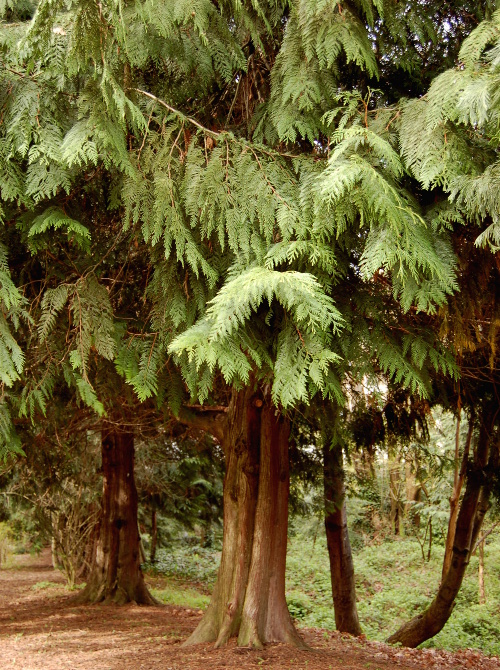
Western red cedar (Thuja plicata) is a majestic, awe-inspiring forest tree of the Pacific Northwest. It can live for hundreds of years. This is one of those trees, like the giant sequoias or the coast redwoods, whose largest representatives have their own names. For example, on Vancouver Island in British Columbia, there is one western red cedar called the Cheewhat Giant, which stands 182 feet tall and has a trunk that measures an incredible 60 feet around.
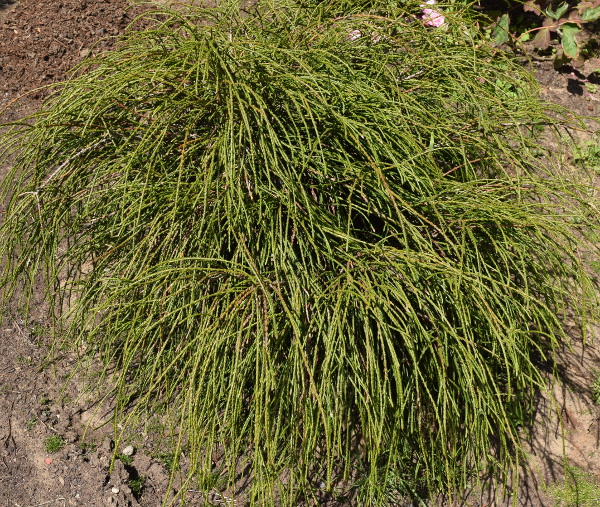
So… ‘Whipcord’ originated as a chance seedling of a tree that can get 200 feet tall and can have a trunk 20 feet thick. ‘Whipcord’ belongs to the same species, yet it maxes out at 5 feet and has radically different foliage.
Think about how crazy that is. It’s as if a pair of Great Danes spontaneously gave birth to a Chihuahua.

Western red cedar, being amenable to carving, resistant to decay, and plentiful in our area, was the tree of choice in the creation of the famous Native American totem poles, such as those by the Haida people of the Pacific Northwest. It was also used to make their canoes, and in A Natural History of North American Trees, Donald Culross Peattie calls Thuja plicata the canoe cedar. The word canoe seems to understate things a bit, because Peattie goes on to say that some of these watercraft were 65 feet long and could carry 40 people!

Today western red cedar is mainly used for building—and for fencing.
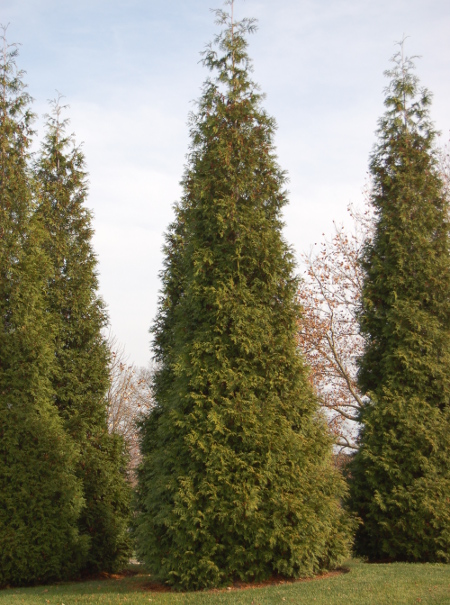
When I left Cincinnati several years ago, Thuja plicata was getting very popular there in the form known as Spring Grove, from Spring Grove Cemetery and Arboretum in Cincinnati. Spring Grove arborvitae gets only 20 to 30 feet tall (at least in the Midwest) and has a neat, dense habit. For some reason, deer don’t bother it, although they love to munch on the eastern arborvitae, Thuja occidentalis. I loved working with Thuja plicata at the nursery, because it smells so good. That sweet resinous scent in the wood is in the foliage, too, making pruning a pleasure.
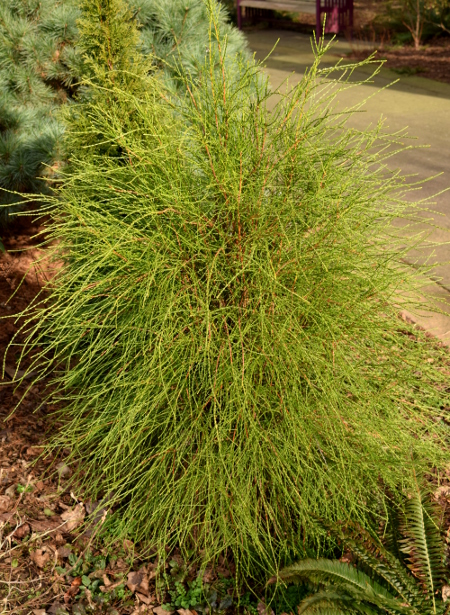
Another funny rat tail plant I have my eye on is ‘Franky Boy’ Oriental arborvitae (Platycladus orientalis ‘Franky Boy’). This one is a more upright grower with chartreuse foliage. Worst case scenario—I’ll have to get both!
Do you grow either of these funky evergreens? What do you think of them?

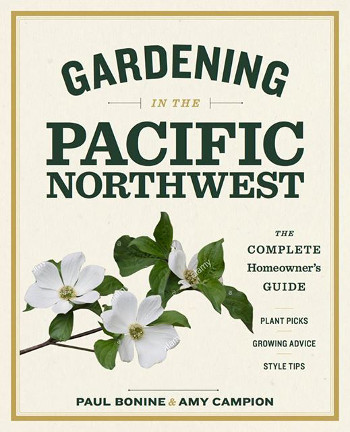























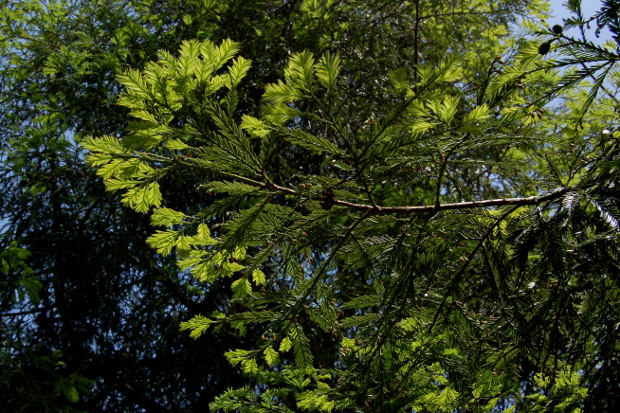


I have ‘Whipcord’ but not in a very good place. It really needs to be raised up somehow, to show off those cascading chords.
That seems to be a popular response – a lot of people have it, but it isn’t looking its best because it isn’t in the right spot.
I’ve got one, out front near the sidewalk – have you spotted it? Very slow growin, probably due to my being stingy with the water… But I do love it.
Yes! I have spotted it. I am thinking it will probably get too big and swamp the Corokia or whatever it is next to, so you should probably just give it to me. 😉
I have one too. Surprise – it is still in its nursery pot! So, still waiting for its forever home. I was just out there yesterday, weighing my (its) options. 🙂
Definitely the kind of plant to buy on impulse and figure out where to put later!
I have two beautiful Whipcords in front of my house. The strange thing is that I live in Far North Dallas TX. One of my Whipcords is probably 8′ and the other almost 7. I would up load pictures if you would like. I know they are very unusual because of my zone (8a)
and because of their size. I don’t do anything special to them. I guess they just like it there. They are the most gorgeous trees I have 🙂
That’s crazy big! I would love to see pictures of those!
Question – can this shrub be used in a large planter? Will it winter ok? – if protected – also is used in a planter – would it winter inside or does it need the cold temps? – I purchased one today – I think it is a cool looking bush/plant/shrub – I would love to use it in a nice glazed pot on my patio – I just don’t want to kill it – if that is not a proper planting location for it – thanks
Hi Brent, It depends on how harsh your winters are, but the short version is yes, it can be overwintered in a pot with protection (wholesale growers keep them in unheated polyhouses over the winter) and yes, it does need to experience some cold weather. I would be more concerned about your nice glazed pot. Are you sure it can handle freezing and thawing? Perhaps the best thing to do would be to keep the plant in the plastic pot and just set it inside the pot. Then, when winter approaches, you could move it to a protected place. You could even bury the pot and all up to the rim in some mulch to insulate the roots. If it starts to get rootbound and you don’t want to plant it in the ground, you could trim the roots (and the top) like bonsai growers do.
Mines in a 15qt container and thriving. We had wind chills of -35°. And it loved it. It’s my Rasta Plant…..
Recently I saw a whipchord as a miniature tree…could I keep this in a large pot in my house? I truly love this plant from the moment I saw it but I have no place, and I mean NO.PLACE. to put this outside.
Thoughts on its being an indoor plant?
Hmmm… it could possibly be kept inside during the growing season if you had a very sunny window, but it has to experience a cold period in the winter, so it would have to at least go into an unheated shed or garage if not outside. It cannot survive without going through its natural dormant period.
I have two Whipcords, one on each side of the step up to my small front porch. They are perfect for hiding the ugly concrete porch foundation. They have grown about 2″ in three years. I guess I thought they would always be very small. No one else has ever mentioned noticing them, but I love the look of them.
Hi, I just bought a Whipcord and live in zone 5. Wondering if it could tolerate being in a large clay pot, I could bring it into the garage in the winter if needed.
Hi, I just bought a Whipcord and live in zone 5. Wondering if it could tolerate being in a large clay pot, I could bring it into the garage in the winter if needed.
My landscaper has 3 on the plan and I live in MA…and am wondering how or if they will do well on this coast. And, how did you them ‘off the ground’ a little so they show off their mop haired look?
How do you set the whipcord bush so the ‘mopping effect’ is highlighted?
It should do well for you on the East Coast. It’s quite adaptable. If you want one that’s up off the ground, you’ll have to get one that’s grafted that way. If it’s branching at ground level, you can’t really change that. You could grow it in a large container or raised bed if you can only find a low-grafted one.
What type of soil and sun exposure does the whipcord prefer? I live in Iowa and have three plants looking for a good spot. Duane Prais
It prefers full sun but can handle light shade and the soil should be decent but it isn’t too picky. Not soggy, not bone dry.
I fell in love with this bush recently… they remind me of plants I see by the beach! I live in Zone 6 (Northwest Ohio) which I think will be OK temperature wise. We have a clay soil, do you think they will grow in a clayish soil? The landscaper will amend the soil some when he pulls out the old bushes, but I am still concerned. Any thoughts?
Yes, as long as drainage is good. They are quite adaptable.
I bought two of these and planted them a couple of days ago. Alot of the tails are laying on the ground and some have turned brown at the tips. Can the brown area be snipped off without harming the plant? My daughter and son-in-law have 3 they planted around their kia pool, but their branches set up higher off the ground. They look great.
Yes, you can trim the brown tips off. Just don’t go too far into the woody part. Stick to the green leafy branches and you can trim away.
Can I keep my Whipcord in the house over the winter? I would like to have it as a house plant.
It may be able to tolerate an unheated covered porch or something like that, but I don’t think it would enjoy a warm room in the house. This is a tree that requires a cold, dormant period as part of its life cycle, it’s not a tropical plant that grows all year.
I have two whipcord in the ground will they come back this year.
Are Whipcords Deer resistance ? We have deer in our Michigan subdivision that love the leafy arborvitae.
Bought two cedar western red whipcords and both love where they are located. About 2 and half feet tall. Winter is coming. We are in zone 5 and get a lot of snow. They are in two very large plastic containers. Do these need to be relocated in an unheated porch or garage or can I keep them outside? Added some cedar mulch inside the pots. If they come in, do they need to be watered? Love the way they look. Debbie
I would bring them into an unheated porch or garage. They will need to be watered, but very sparingly.
Excellent article, Amy! I love the background info and your putting things in context. Please check out my website on trees: http://www.lancastercountytrees.org
Hi! Mine is about 4 years old l, and I so desperately want it to be healthy. It is all brown in the middle. Can you tell me what I can do to help it? It is about 10” tall 18” in diameter. Should I fertilize it?
Amy, I live in Chicago area, and I’m also looking forward to your response to Tressa’s questions. I garaged my beautiful potted Whipcord of similar size during the winter, and partially insulated the drained pot to protect the roots from freezing. Occasionally watered it, and it stayed lush green throughout. Moved it to patio about end of March, and it soon started turning brown, although there is still some green on some of the cords. Might it have gone into dormancy in the process? If so, is this stage an annual occurance, and how long does it prevail?
Hi Amy, I have 7 whipcords that I planted last year. They’ve done great all winter. A few days ago I watered them for the first time since winter has ended. Within 2 days all 7 are yellow or brown. Any ideas what I’m doing wrong? I would love to be able to save them!
Great info! Thank you
Curious if I can keep trimming them and keep them small. I just grabbed 3 1# containers and want to keep them mostly the size they are. Would I trim only in spring or would through out the season be appropriate for my goal.
I have 4 Whipcord plants that I planted last Fall. Right now I have 1/2 green and 1/2 brown cords down to the ground . Do I trim the brown cords ? How far down ? Any other suggestions ?
I love this plant in a container near my front door. I’m in southwestern CT, zone 6…I was sure it would die over the winter, but it cooperated and didn’t! It’s so stylish, and different…I’ve begun to use it in various projects (I am a landscape designer). I’d be happy to post a photo or two if I can figure out how.
I have two whipcord in the ground will they come back this year.
Does anyone have any experience with damage from deer or rabbits with this plant. I am in love with it but tired of feeding our native animals gourmet meals. LOL. Thanks.
I have a question I’m wondering if someone could answer. I am planting three large whipcords near my pool – there is a good amount of sun throughout the day but my main question is about the soil as the top layer of soil (perhaps the first foot) is fine but underneath it’s basically sand. Am I wasting my time planting the arborvitae in that type of soil or are there any suggestions?
I have a 2 year old. So far no rabbit damage. Solid clay here (literally, this is where they made bricks) and it’s doing fine.
How deep a pot should the whipcord tree have to be for the root growth?